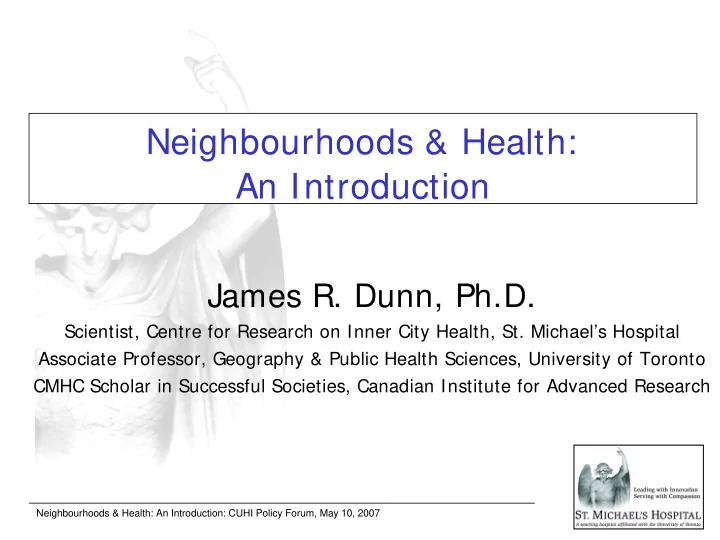

Neighbourhoods & Health: An Introduction James R. Dunn, Ph.D. Scientist, Centre for Research on Inner City Health, St. Michael’s Hospital Associate Professor, Geography & Public Health Sciences, University of Toronto CMHC Scholar in Successful Societies, Canadian Institute for Advanced Research Neighbourhoods & Health: An Introduction: CUHI Policy Forum, May 10, 2007
The Social Gradient in Health Neighbourhoods & Health: An Introduction: CUHI Policy Forum, May 10, 2007 Source: Humphries and van Doorslaer Doorslaer, 2000 , 2000 Source: Humphries and van
Income and Social Status • Canadian studies show that on average: – Men in the top 20% of the income scale live 6 years longer than those in the bottom 20%. They can expect 14 more years of disability-free life. – Women in the top 20% of the income scale live 3 years longer than those in the bottom 20%. They can expect 8 more years of disability-free life. Neighbourhoods & Health: An Introduction: CUHI Policy Forum, May 10, 2007
Mortality Rates by Neighbourhood Income: Urban Canada, 1971-1996 % 45 40 35 Q1-Richest 30 Q2 25 Q3 20 Q4 15 Q5-Poorest 10 5 0 1971 1986 1991 1996 Neighbourhoods & Health: An Introduction: CUHI Policy Forum, May 10, 2007 Mortality by Neighbourhood Income in Urban Canada, Wilkins R, Berthelot JM, Ng E, March 2001
PYLL(0-74) by Cause, 1996 0 5 10 15 20 25 30 35 30.9 Neoplasms 23.1 I ncome-Related 19.2 I njuries 17.6 Circulatory 5.3 I nfectious 4.9 Perinatal 4.8 I ll-defined 3.8 Congenital 13.5 All other
“medicine and politics cannot and should not be kept apart” Sir Geoffrey Rose, MD (1992) Neighbourhoods & Health: An Introduction: CUHI Policy Forum, May 10, 2007
The Logic of Neighbourhoods & Health Research • health behaviours and health status are the outcome of more than just individual factors (e.g., income, attitudes, etc.) • health behaviours are significantly shaped by ‘health opportunity structures’ • e.g., availability of parks & rec, healthy foods, etc. • health outcomes shaped by more than just individual socio-economic status • low SES individuals = > ‘deprivation amplification’ Neighbourhoods & Health: An Introduction: CUHI Policy Forum, May 10, 2007
Attributes of Neighbourhoods with Links to Health: 5 R’s • risks: environmental contaminants, crime, violence, noise, and dangerous roadways or pedestrian pathways or crossings • resources: health & social services, commercial services, schools, recreational opportunities, libraries, public transit, built environment - physical activity Neighbourhoods & Health: An Introduction: CUHI Policy Forum, May 10, 2007
Attributes of Neighbourhoods with Links to Health: 5 R’s • relationships: social support, social capital, social cohesion, ‘weak ties’ collective efficacy, etc. • representations: the reputation of a neighbourhood • residents may internalize = > self-worth • may have an effect on service provision, movement of people, investment in the neighbourhood • resilience? Neighbourhoods & Health: An Introduction: CUHI Policy Forum, May 10, 2007
Pathways Linking Neighbourhoods & Health • Direct: • behavioural • stress / coping • I ndirect: • neighbourhood reputation • political power • Both direct & indirect: • social relationships, social capital, etc. Neighbourhoods & Health: An Introduction: CUHI Policy Forum, May 10, 2007
Current Activities a) Toronto-IRONhI: Intensive Research on Neighbourhoods & Health Initiative � structured observation of social & physical disorder � concept mapping re: n’hood features that affect mental health & well-being � Rapid Small-Area Health Needs Assessment b) Toronto Area Health Study � neighbourhood factors in inequalities in mental health c) SMH Health Database Initiative � n’hood variation in health & health determinants � Ontario Urban Health Atlas Volumes 1-? in development: child health, mental health, respiratory health… Neighbourhoods & Health: An Introduction: CUHI Policy Forum, May 10, 2007
Future Themes, Directions, Issues • policy is leading the research – good news in a way • evaluating complex, population-level interventions – new methods for understanding how & why of health effects of complex neighbourhood intervention = > ‘realistic evaluation’: mechanism + context = outcome • knowledge translation & receptor capacity in multiple sectors • more work on ‘natural experiments’, eg. Regent Park, Priority N’hoods Strategy, etc. • panel study of residents clustered in n’hoods with tracking of movers Neighbourhoods & Health: An Introduction: CUHI Policy Forum, May 10, 2007
Recommend
More recommend